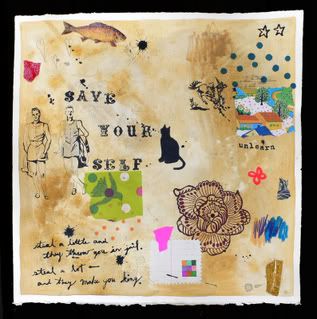
Cara Ober. "Save Your Self." 2007. Mixed Media on Paper. 16x16.( I guess that qualifies as a 'collage.' but I don't really think of my self as a 'collage artist.')
By Sam Sessa and Glenn McNatt | Sun reporters
Friday, January 25, 2008
Baltimore collage artist Cara Ober recently started fielding e-mails from friends, asking about her new show, a collection of more than a dozen paintings displayed downtown.
The problem was, it wasn't Ober's work - it just looked like it.
The exhibit, New Work by Christine Bailey, went on display in the lobby of the T. Rowe Price office building earlier this month. Unlike Bailey's previous work, the paintings intentionally mimicked Ober's style. But for Ober, it was far from an homage.
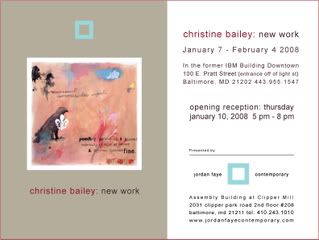
"The best analogy is this: How would you feel if someone stole something from you that you loved and cared for?" said Ober, 33, who lives in Charles Village and teaches art classes at the Maryland Institute College of Art. "It's a bitter pill to swallow."
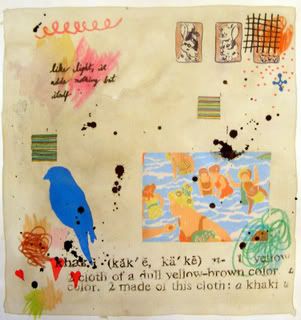
Cara Ober. "Untitled from the Meshuggeneh Series (blue bird)." 2006. mixed media on paper. 11x11 inches.
New Work has struck a nerve in the local arts community as well, with some calling it underhanded and others offering praise. But most acknowledge that the show raises the question of what qualifies as artistic plagiarism.
"On the one hand, the success of any act of appropriation requires a knowledge of the source," said Irene Hoffman, director of the Contemporary Museum. "Was the appropriation evident to the audience? If so, it's a very similar gesture to those of other, more famous artists, where the audience recognizes the source."
The concept of appropriating or borrowing elements from art history and popular culture to create new works has a long tradition. Andy Warhol became famous for his images of soup cans and of celebrities such as Marilyn Monroe and Jacqueline Kennedy. Roy Lichtenstein made large-scale paintings based on comic-book characters and situations.
But with New Work, Bailey wanted to experiment with the practice of appropriating on a more local and personal level, she said. She aimed to challenge the business model of art-making within the marketplace and present it in a new light, she said.
"For me, this was very much a project about how or if I could steal someone's artistic identity and what that would look like," Bailey wrote in an e-mail to Ober. "Could I be the Old Navy to Cara Ober's The Gap?"
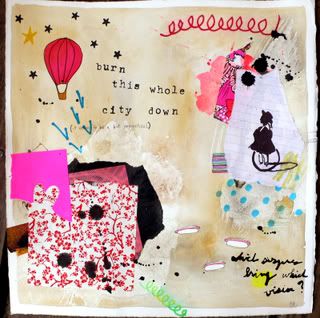
Cara Ober. Untitled from the Meshuggeneh Series (burn this whole city down). 2007. Mixed Media on Paper. 12x12 inches.
After the show went up, curator Jordan Faye Block began receiving e-mail about the exhibit. Some messages were derogatory, others encouraging.
"I think that to get a dialogue going and to push the envelope a little bit, sometimes things need to be done," Block said.
The show opened Jan. 7 and runs through Feb. 4. On Jan. 10, the day of the exhibit's opening reception, Bailey e-mailed an explanation of her motives behind New Work after she learned that the show had offended Ober.
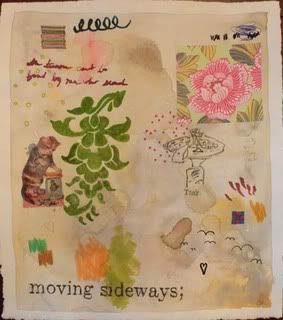
Cara Ober. "Untitled from the Meshuggeneh Series (moving sideways)." 2006. mixed media on paper. 11x11 inches.
"This was not a project about attacking any one person," Bailey said. "She's not the only one working in this style. She is of course the closest to home, so that resonates."
Several days later, Ober asked for an apology and a public explanation. Bailey agreed to both, and posted an artist's statement next to the artwork that explained that she had used Ober's work as a point of reference.
Julie Ann Cavnor, executive director of Maryland Art Place, understands Bailey's idea with New Work but objects to the way it was carried out. She felt the exhibit was an attempt to turn heads and an affront to Ober.
"It's an inappropriate way to gain public attention," said Cavnor. "It's beyond derivative. It was a very intentional attack on Cara's work."
Bailey has consistently examined the concept of identity through various media. New Work was a departure for her stylistically but not thematically, she said.

Christine Bailey. "Stay Stag." 2008. Mixed media on Paper. Size Unknown.
In emulating the manner of Ober's paintings, Bailey appropriated a number of stylistic devices that appear regularly in Ober's work, including short sections of text that mimic dictionary definitions and other reference sources, naive renderings of flowers, plants and animals, and washes of pastel colors applied in layers that establish the overall mood of the image.
Appropriation is not a new idea. The 19th-century Impressionist painter Edouard Manet, for example, borrowed the central figures of his famous painting The Luncheon on the Grass from an engraving by the 16th-century Italian artist Marcantonio Raimondi. More recently, conceptual artists such as Sherrie Levine and Richard Prince have stirred controversy by photographing iconic advertisements and classic images by well-known photographers and then presenting them as original artworks. The art world has largely accepted their appropriations as a legitimate artistic practice.
Working in a specific style of collage and drawing from similar components is different from blatant reproduction, said Jay Fisher, deputy director for curatorial affairs at the Baltimore Museum of Art.
"The rules don't change just because you're in Baltimore," Fisher said. "When you're part of a community, it's important to be sensitive to the other members of the community. But that doesn't really change the situation that artists should be entitled to have free latitude in how they develop their imagery."
Originally, the exhibit was to have featured works by Bailey and the Washington-based abstract painter Isabel Manalo. But Manalo declined to have her paintings shown with Bailey's because she felt they would not conceptually fit together, and she objected to Bailey's approach.
"If [Ober] was part of that whole conversation before it actually was up, then I think it could have been a really cool collaboration," Manalo said. "But she wasn't. So there are some questionable choices there."

"Outer Beltway Homicide" by Isabel Manalo.
Though Bailey regrets causing Ober any distress, she stands behind the artwork in her exhibit.
"On a personal level, I have no interest in hurting anybody," Bailey said in an interview yesterday. "But in terms of the work, that wasn't particularly relevant to the body of work."
Even with the apology and correction, Ober said she feels used and at a loss for words about the exhibit.
"I don't know what to say," Ober said. "It is controversial and it raises eyebrows and makes people angry. If that was the goal, then it's a success."
sam.sessa@baltsun.com glenn.mcnatt@baltsun.com

No comments:
Post a Comment